RFC Liège have a rich and storied history in Belgian football. The club was founded in 1892 and became the first-ever Belgian champion in 1896, with the club having a long period as one of the best sides in Belgian football. They also competed in European competitions in the 1980s, facing the likes of Juventus, Benfica, and Werder Bremen. However, they have recently fallen on hard times, dropping all the way to the 4th division of Belgian football as recently as 2011.
Now, under the guidance of former Belgian international Gaëtan Englebert, a former RFC Liège player who was born in the city, the club achieved promotion from the Belgian First Division 1 last season, finishing 2nd and allowing them to participate in the Challenger Pro League. They have now proceeded to have a great start to the season in the second division, with the club sitting in 4th, 3 points off 1st place. This tactical analysis and scout report will look at some tactics employed by Englerbert and how they have allowed them to find themselves in their position after just achieving promotion.
Looking to utilise the entire width of the pitch in attack
When it comes to how RFC Liège look to attack, a lot of their goalscoring chances this season have originated from transitional moments, with the Belgian side only averaging around 43% possession in their matches in the Challenger Pro League so far this season. They look to be dangerous in transition by looking to use the full width of the pitch to their advantage, to overload these wide areas and play into the runs of the fullbacks or wide midfielders in Englebert’s preferred 4-2-3-1 formation. This then results in plenty of services from wide areas by RFC Liège, with this a common way for them to create goalscoring chances.
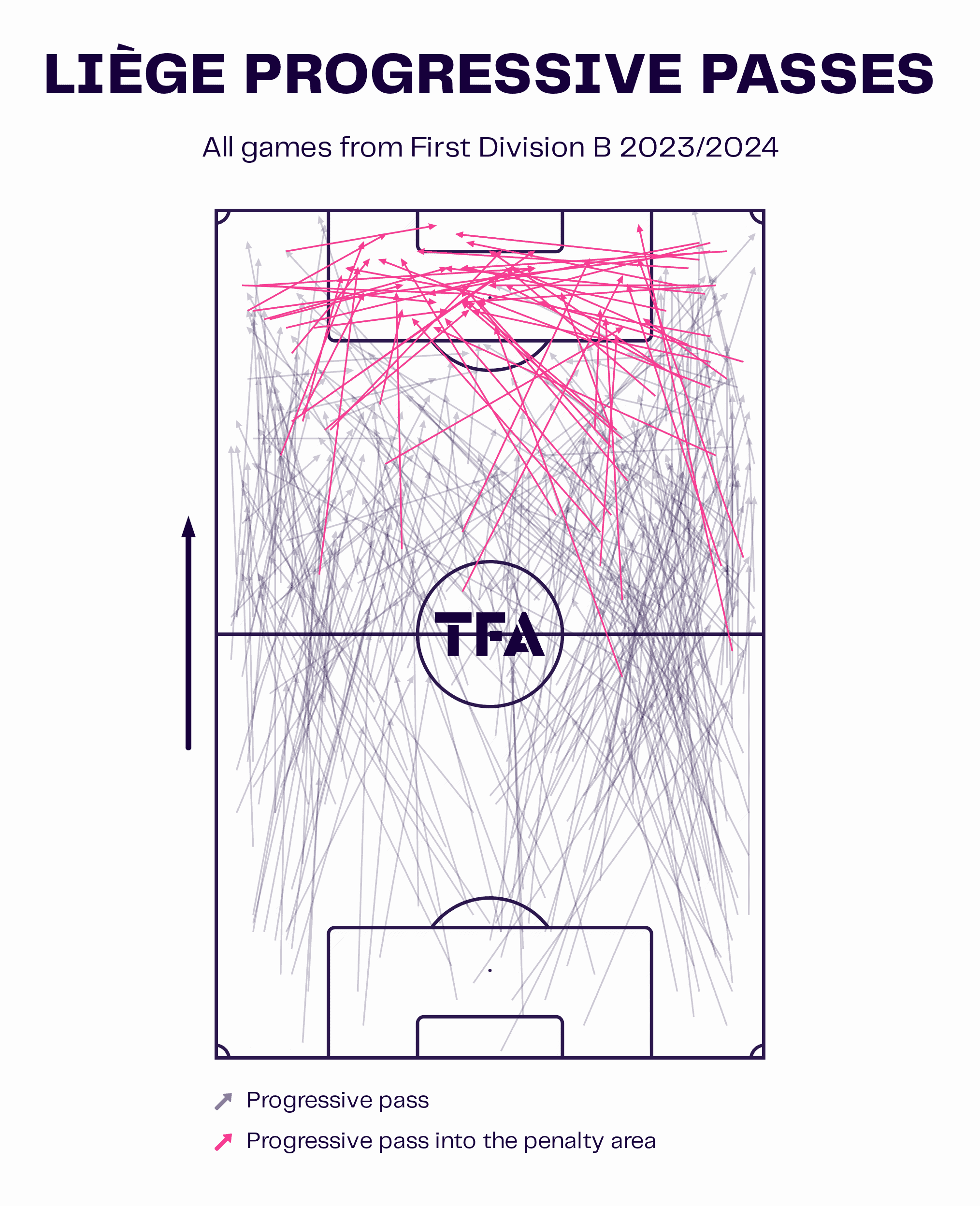
The data viz graphic above shows the progressive passes from RFC Liège this season, highlighting this tendency for the Belgian side to prioritise playing the ball into the wide channels to create chances going forward. As we can see from the graphic, the pink arrows indicate progressive passes into the penalty area, most of which are played from either a long ball from deep or a cross after driving towards the endline.
It is common to see the strong side midfielder in the double pivot rotate out into the wide channel, looking to create an overload or create a combination play with the advancing fullback and the wide midfielder on this side. This also paints the picture of why there is a high concentration of progressive passes in the zone between the wide channel and the centre of the park; the movement of the defensive midfielder into this wide area contributes to creating width.
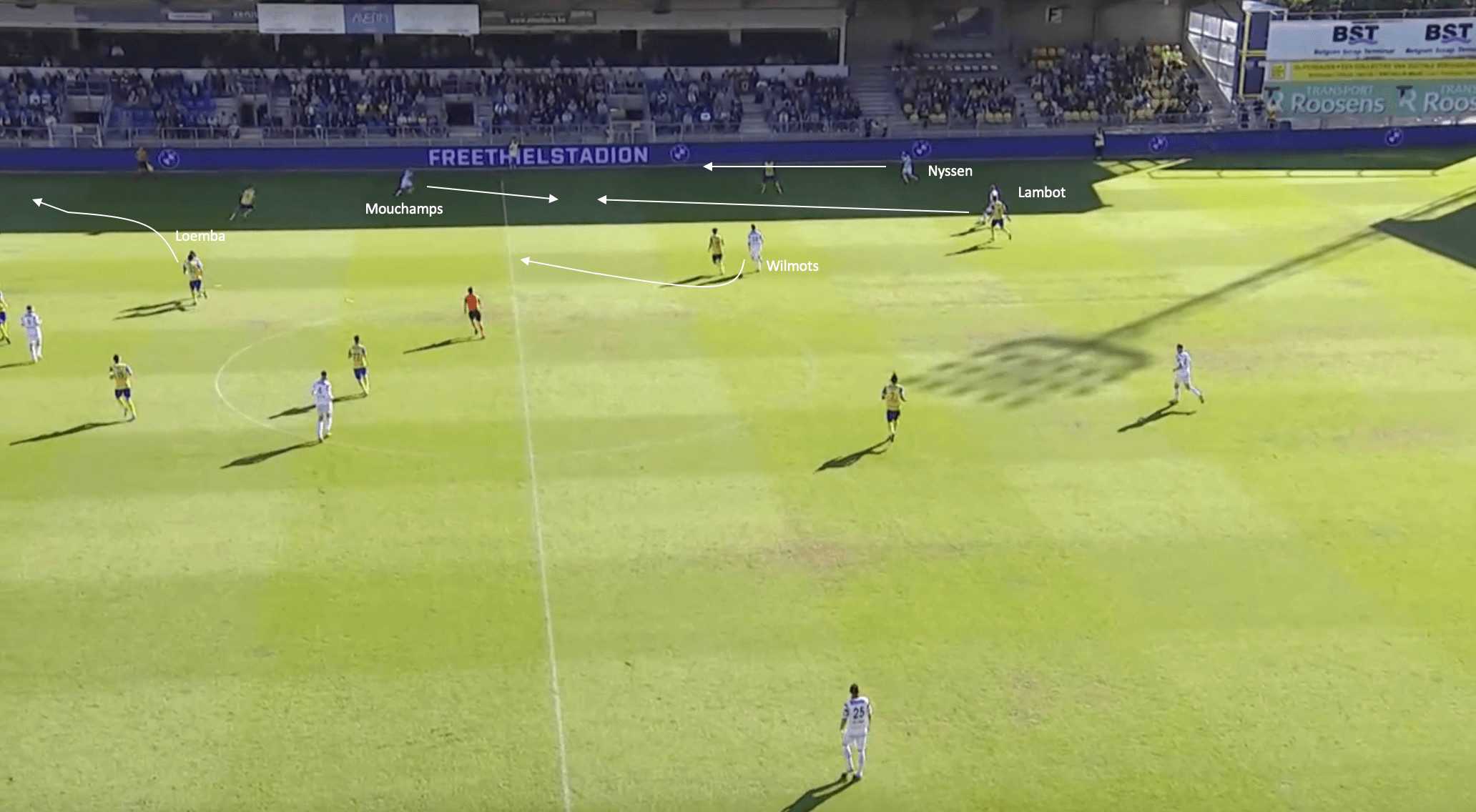
The image above shows an excellent example of how RFC Liège have looked to progress the ball into the final third this season under Gaëtan Englebert. As explained by the graphic, the Belgian side look to play the ball wide, with it standard for multiple players to shift over and support in playing in the wide channels.
In this phase of play from a recent match against SK Beveren, the ball is currently in possession of the centre-back, Benjamin Lambot. The Belgian defender drives slightly forward before playing into the feet of the wide midfielder, Damien Mouchamps, who drops into a deeper position to receive the ball uncontested. This also attracts the attention of the Bevern fullback, who gets dragged out of position by the movement of the Belgian attacking midfielder.
At the same time, the fullback, Benoît Nyssen, makes an overlapping run into the space vacated by Mouchamps, with attacking midfielder Yannick Loemba making a run into the area vacated by the Bevern defender. This is where the combination play in this wide channel comes into effect for Liège. As Mouchamps receives the ball, he plays a first-time pass into the path of defensive midfielder Reno Wilmots, with the Belgian taking a touch before playing into the run of Loemba behind the opposition defence.
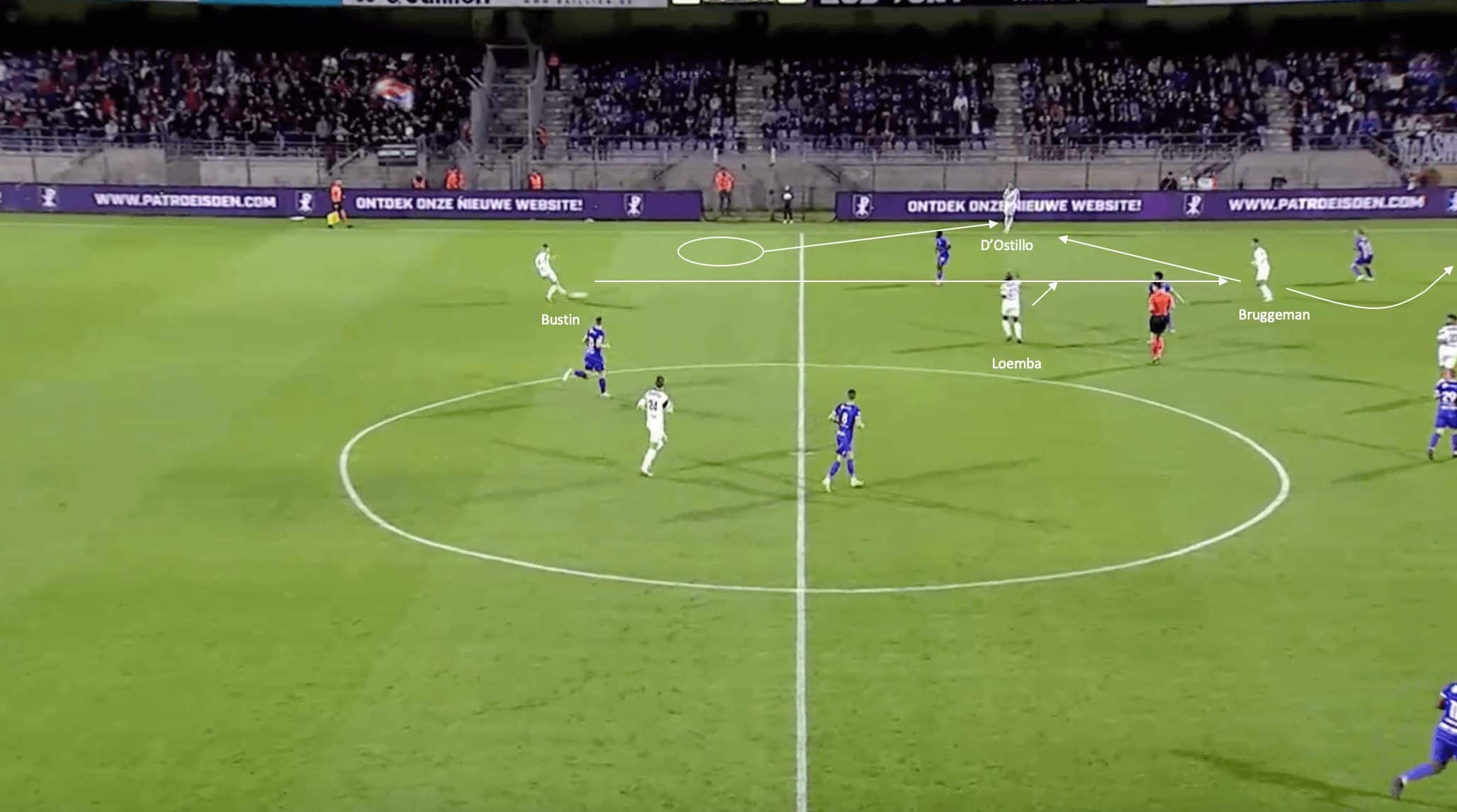
The image above shows another attacking phase from Liège, resulting in quick ball progression through outlets in the wide spaces. The ball is currently in possession of the left-sided central defender, Jordan Bustin, with the 25-year-old looking only to play forward. Benoît Bruggeman, the left-sided attacking midfielder, tucks inside, showing as an option between the Patro Eisden lines.
Jonathan D’Ostillo, the left-sided fullback, advances but stays wide, hugging the touchline and forcing the Patro Eisden fullback to be caught between whether to mark the fullback wide or midfielder tucked inside. Also, Loemba moves wider, looking to be involved in the play in the half-space. This is now where the quick combination play and passing sequences comes into effect for this Liège side.
As Bustin plays the ball to Bruggeman, the Belgian midfielder looks to play a quick one-two with D’Ostillo, with the midfielder playing a first-time ball out to the fullback before turning and running beyond the frozen fullback. Unfortunately, the ball played wide forces the fullback to move backwards, allowing time for the Patro Eisden defender to close him down and force him back to where it came from.
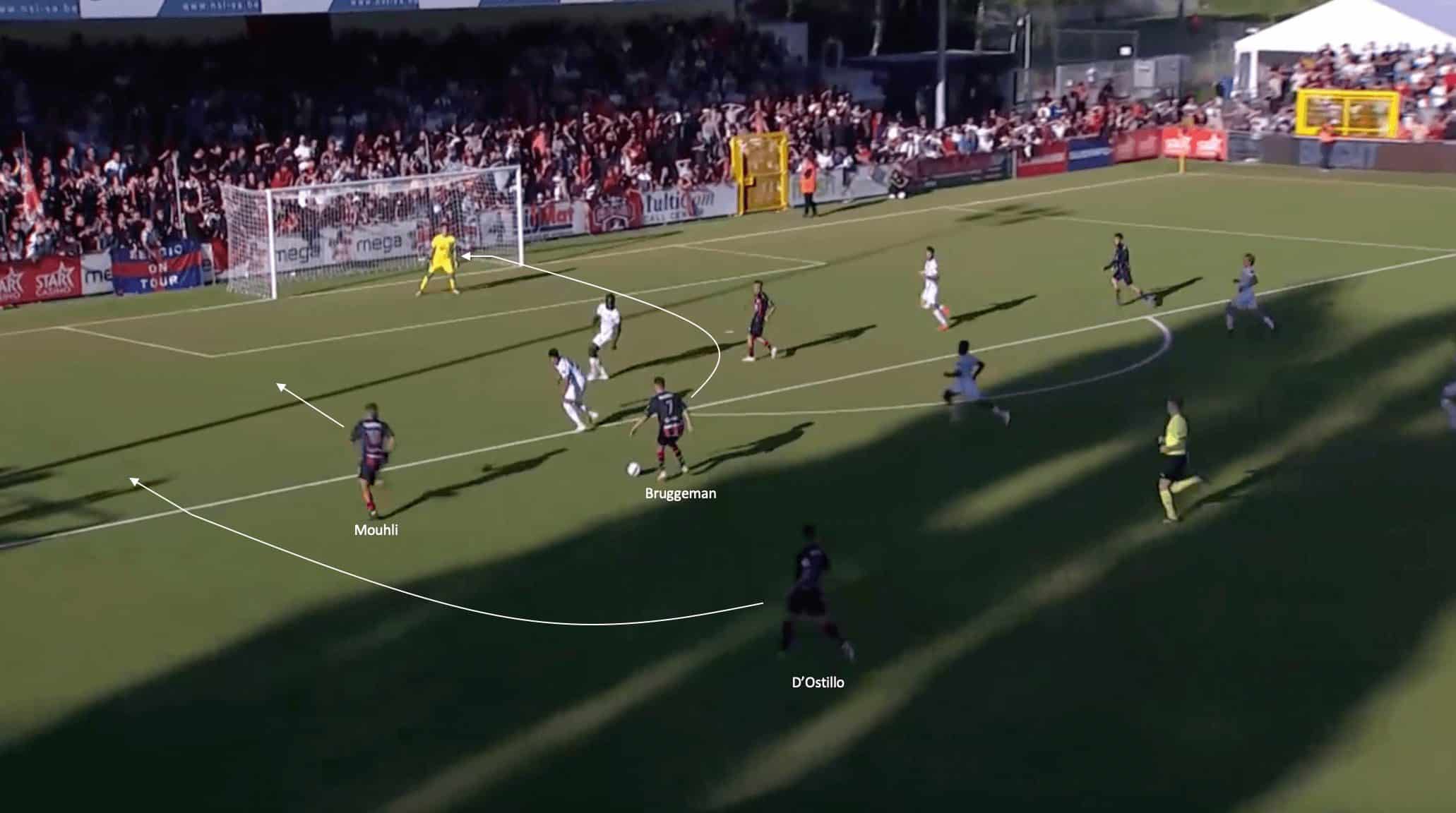
Sometimes, Liège’s width is used more as a decoy, like in this attacking phase of play against Manchester City-owned Lommel, managed by former Arsenal defender Steve Bould. This attacking move started in Liège’s defensive half, with the ball turning over and allowing the Belgian side to hit Lommel on a quick, transitional attacking move. The ball can quickly find its way to Bruggeman, who narrows off so he is more in frame and able to get a shot off if the opportunity arises.
As the Bruggeman begins to slow play down, this allows time for both Mohamed Mouhli and fullback D’Ostillo to make overlapping runs beyond the attacking midfielder, which at the same time makes them potential options to be played endline before sending a ball across the box. However, this time, the width is used as a decoy. Mouhli’s movement catches the Lommel fullback, with him unsure whether to go out and press the player in possession or move wide to mark the overlapping run of the 25-year-old Belgian.
This indecision allows Bruggeman the time and space to get a shot off on goal, though the goalkeeper saves it. As this section has shown, Gaëtan Englebert’s side rely on the width in attacking phases of play, whether it be quick combination play and passing sequences, overloads in these areas to create chances, or decoys to open space for shots centrally.
Looking to keep the game in front defensively and lock play to one side
When it comes to RFC Liège from a defensive perspective this season, one of the common tendencies from the Belgian side is looking to keep the game in front of them. With nine goals conceded so far this season, it is one of the lowest totals in the Challenger Pro League, and a lot of this is down to their solid and relatively consistent defensive shape.
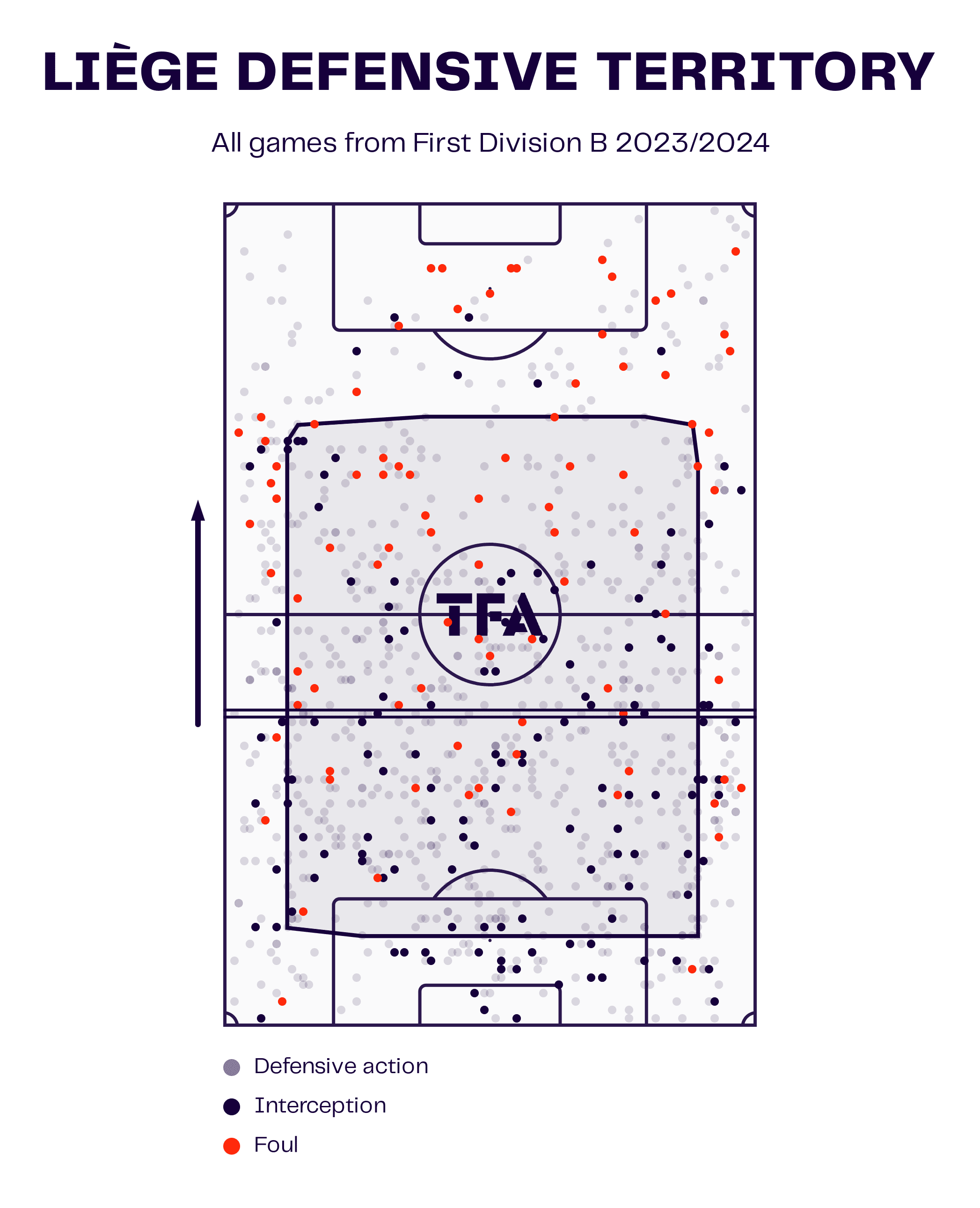
The data viz graphic above shows the defensive territory of RFC Liège this season, highlighting their average line of confrontation and all the defensive actions they have committed this season. As we can see from the graphic, the majority of defensive actions from the Belgian side have occurred in areas in the middle and early defensive third of the pitch. This shows that Liège look to keep the play in front of them, with their defensive line looking to drop off rather than be aggressive and stay high to put pressure on opposition sides.
This starts from the front, with Liège being one of the least aggressive pressing sides in the Challenger Pro League. With a PPDA of 11.06, they do not look to press aggressively; they instead look to lock play to one side before putting pressure on the opposition. They have also blocked 35 shots this season, the 2nd highest total in the Challenger Pro League, showing their will to get in front of shots and stop them rather than having to track back in defensive phases.
Starting by looking at the defensive work that the Liège forwards do, the ability for the attacking players to consistently lock the ball to one side allows them to be successful in winning possession back in advanced areas, all without needing to keep a high line and run the risk of players getting beyond the backline and in behind.
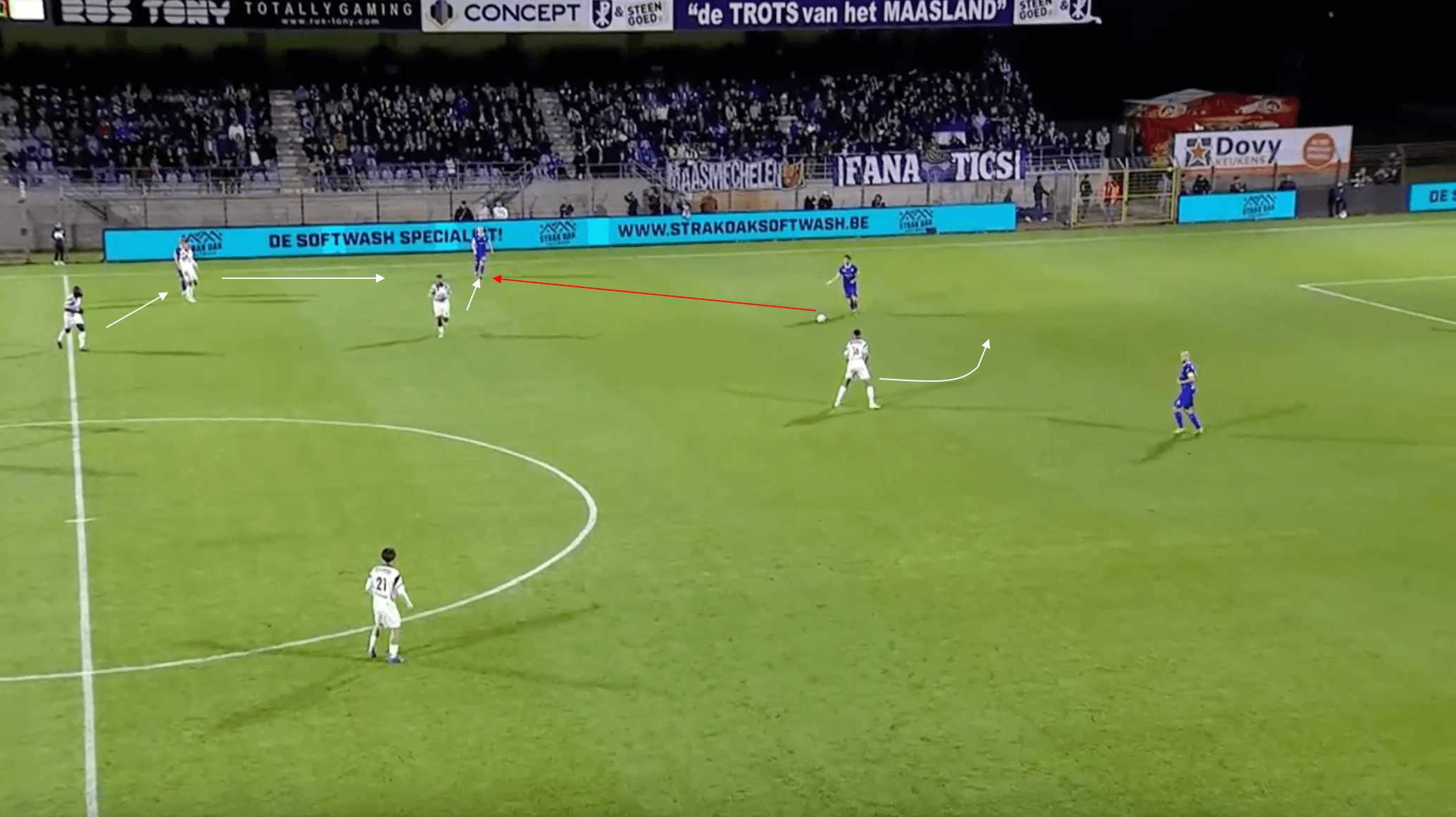
In this phase of play above against Patro Eisden, we can see this strategy of locking the ball to one side in full effect. As Patro looks to build out from the back, the Liège forward makes a brilliant bent run towards the player in possession, eliminating the possibility of switching the play through the other central defender. As this happens, the other Liège players all look to engage the opposition fullback, as this is the best option for the defender to progress the ball.
As the fullback receives the ball, he is instantly closed down, with him sending the ball out of play off a Liège player for a Patro throw-in. While the Belgian side cannot regain possession, it allows them more time to get set up defensively due to the ball going out of play. This tactic of smartly locking the ball to one side will enable them to keep the ball in front of them from a defensive standpoint instead of pressing high and getting balls played over the top of their defence.
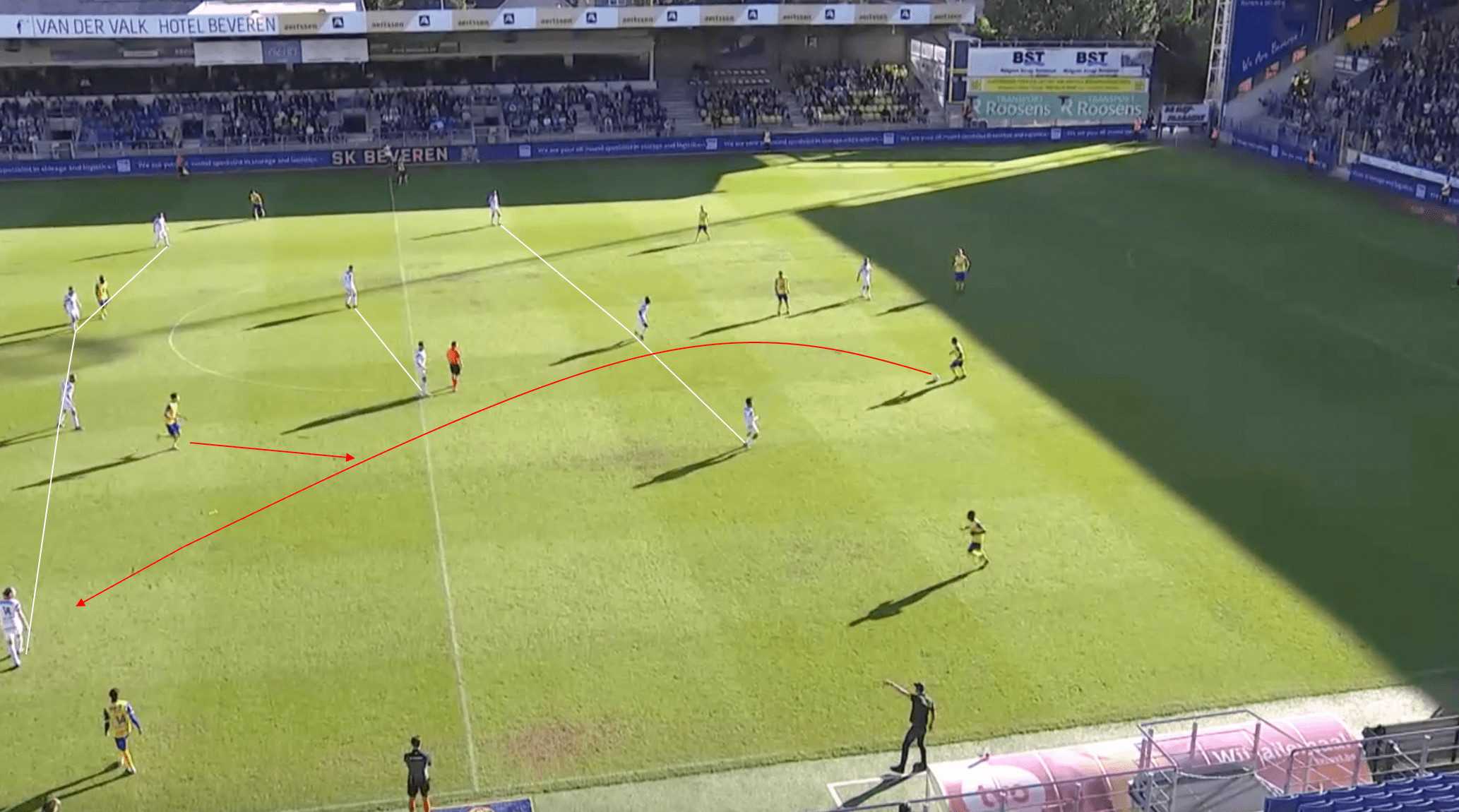
The image above shows one example of how Liège’s defence looks to keep the ball in front of them. SK Beveren have possession and want to build with Liège in their 4-2-3-1 shape. With few passing options showing themselves, the Beveren striker pops off the backline, looking to drop into a pocket of space between the lines. However, the centre-back from Liège does not follow, allowing him to drop into the space and potentially receive the ball.
This goes back to keeping the ball in front of them, with the Liège defenders not wanting to be dragged out of position and opening up space for runners to make runs beyond the backline. The ensuing pass from the Beveren defender looks for the striker. Still, it puts too much on the pass, with the Liège fullback able to receive possession and eliminate the Beveren attack. If the defender would have tracked the runner into the midfield, it would have opened up a potential ball over the top of the backline, with the second Beveren striker then able to run into the space that the defender would have vacated.
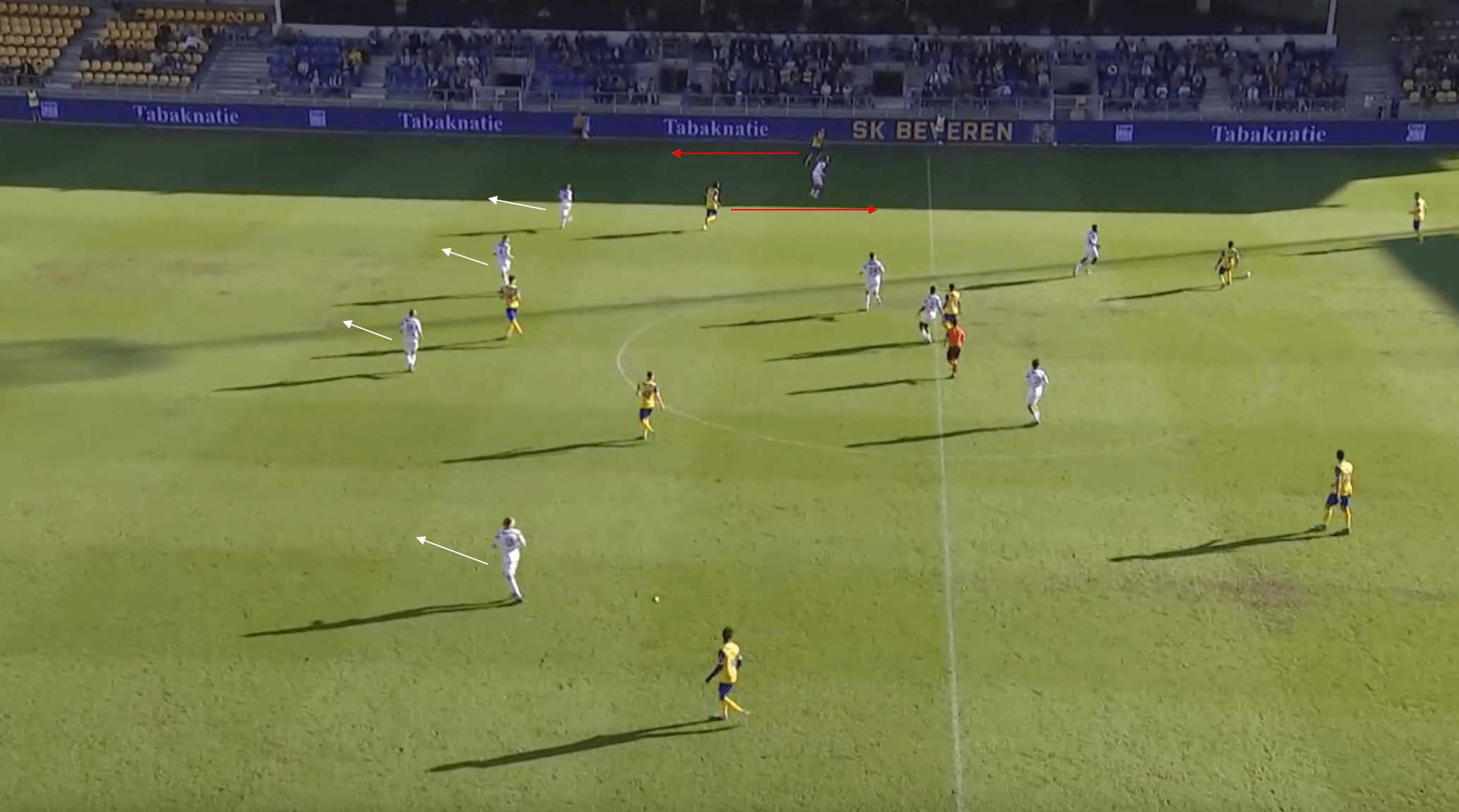
The image above again shows the discipline the Liège backline shows when forwards look to make runs, checking off the backline into space. However, to keep the ball in front, the Liège backline instead looks to drop off, allowing Beveren to receive the ball unmarked between the lines. This is once again a good reading of the game by the Liège defenders, especially the fullback, with the Beveren fullback on the far side looking to make a run into the space if the fullback would have stepped into midfield.
As this section has shown, Gaëtan Englebert has turned this Liège side into a disciplined and compact defensive outfit this season. While the season is still young, and it is possible that this may not continue, it’s been a great start defensively for the Belgian side in their first season back in the second tier of Belgian football.
Conclusion
As this tactical analysis and scout report has shown, RFC Liège have had an excellent start to the Challenger Pro League season under Gaëtan Englebert. From both an attacking and defensive point of view, the Belgian side have what it takes to stay in with a chance of promotion for the whole season.





Comments